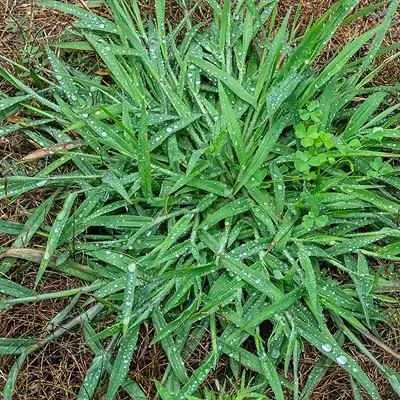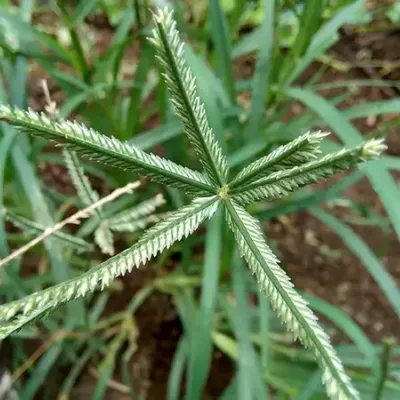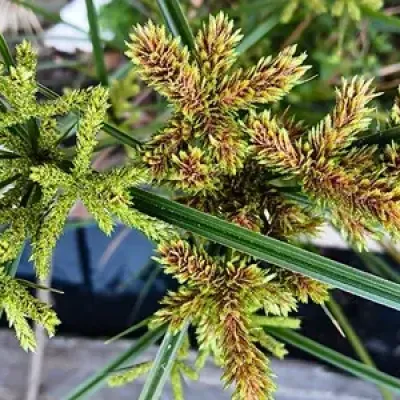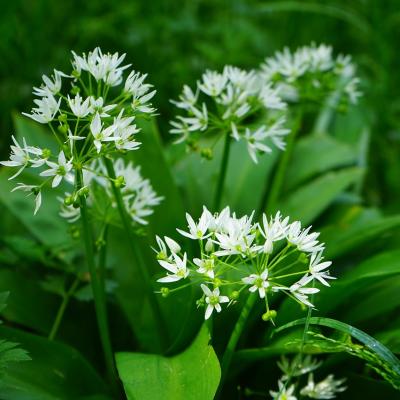How To Identify the Most Common Weeds in Texas

Weeds can be a major nuisance in Texas yards, especially with the state's diverse climate and growing seasons. Whether you're in the humid East, the dry West, or the central plains, weeds will thrive if left unchecked. But fear not! With a little knowledge, you can easily identify and manage the most common weeds in Texas. Here’s your ultimate guide to spotting these unwelcome guests in your backyard.
Bermuda Grass (Cynodon dactylon) – Yes, it’s a Weed!

When to Spot It: Spring through Fall
Where It Grows: Warm-season grass, thrives in hot, sunny areas, well-drained soil, and drought-tolerant conditions. Prefers full sun and can tolerate moderate foot traffic.
What It Looks Like: Bermuda grass is a warm-season grass that is often used as lawn grass, but it can act as a weed in areas where it’s not wanted. It has thin, wiry, dark green blades that grow in dense mats. The plant sends out stolons (runners) that spread across the ground, often invading garden beds, flower beds, and any area with bare soil. Bermuda grass can grow between 4 and 12 inches in height, but it often spreads horizontally, making it hard to distinguish in crowded areas. It produces small seed heads that are usually green but can turn brown or purple when mature.
Why it’s a Problem: Bermuda grass is highly invasive and can take over garden spaces or other areas where you don’t want it. Its creeping nature means it will keep spreading unless controlled.
Chickweed (Stellaria media)

When to Spot It: Winter to Spring
Where It Grows: Prefers cooler temperatures, typically growing in shady, moist, and fertile areas, especially during fall and spring.
What It Looks Like: Chickweed is a low-growing, spreading plant with small, roundish leaves that are bright green and opposite each other on the stem. The plant produces small, star-like white flowers, usually with five petals that are deeply notched. Chickweed can grow to about 4 to 8 inches in height, often forming a dense mat across the ground.
Why it’s a Problem: Chickweed thrives in moist, shady areas and can rapidly spread across your lawn, competing with grass and other desirable plants.
Clover (Trifolium repens)

When to Spot It: Spring and Summer
Where It Grows: Thrives in well-drained, fertile soil, especially in areas with partial shade. It does well in moderately acidic soils and is often seen in lawns with low nitrogen levels.
What It Looks Like: Clover is a small, low-growing plant that typically spreads through runners, forming a dense mat in the soil. It has distinctive three-leaf clusters that are oval in shape. The leaves are bright green and often have a small white or cream-colored crescent-shaped mark near the center of each leaf. The plant produces small flowers that can be white or pink, depending on the variety. Clover flowers grow in rounded clusters that rise above the leaves on short stems. The height of the plant ranges from 6 to 12 inches, depending on the growing conditions.
Why it’s a Problem: Clover thrives in nutrient-poor soil and can quickly spread across your lawn, taking over and pushing out grass. While it’s low-maintenance, it can make your lawn look patchy if not controlled.
Crabgrass (Digitaria spp.)

When to Spot It: Spring and Summer
Where It Grows: Grows best in hot, dry weather, particularly in disturbed, compacted soils. Prefers full sun and tends to invade lawns with poor soil quality or weak turf.
What It Looks Like: Crabgrass is a warm-season annual that thrives in hot weather. It typically grows low to the ground, forming a dense mat. The blades are wide, flat, and light green, spreading out in a star-like pattern from the central point of the plant. You’ll often see it popping up in patches, especially in areas with bare or stressed soil. During the summer, it produces a tall seed head that can range from 6 to 12 inches in height. These seed heads are arranged in a spiky, bush-like structure with green to purplish tones.
Why it’s a Problem: Crabgrass grows aggressively and can quickly crowd out healthy grass, leaving large, unsightly patches of bare soil. Its ability to reseed itself easily makes it difficult to control once it establishes itself.
Curly Dock (Rumex crispus)

When to Spot It: Spring to Fall
Where It Grows: Prefers moist, well-drained soil, and often grows in disturbed areas like fields, roadsides, and gardens. Thrives in both sun and partial shade.
What It Looks Like: Curly dock is a perennial weed that can grow up to 3 feet tall. It has large, lance-shaped leaves that are wavy or curly along the edges. The leaves are often reddish or purple at the base, and the plant produces long, slender flower stalks that bear tiny greenish-brown flowers. These flowers eventually turn into brownish seed clusters.
Why it’s a Problem: Curly dock thrives in disturbed soils and can quickly become a nuisance in your garden or lawn. Its deep taproot makes it hard to pull out, and its seeds can spread easily.
Dallisgrass (Paspalum dilatatum)

When to Spot It: Spring to Fall
Where It Grows: Thrives in warm, sunny areas with well-drained soil. Often found in lawns, pastures, and disturbed areas. Prefers moderately moist conditions.
What It Looks Like: Dallisgrass has broad, dark green leaves with a rough texture. The plant grows in clumps and can reach heights of up to 12 inches. It has a distinctive, feathery seed head that grows in a tight, upright formation. The seed heads are purplish and soft, with each seed sitting in its own little segment on the flower stalk. The plant itself is a perennial, meaning it will come back year after year if left uncontrolled.
Why it’s a Problem: Dallisgrass is aggressive and can easily overtake your lawn, particularly in the summer heat. Its ability to spread through seeds and rhizomes makes it tough to eliminate once it’s established.
Dandelions (Taraxacum officinale)

When to Spot It: Spring through Fall
Where It Grows: Thrives in full sun but can also tolerate some shade. Prefers disturbed soils, including lawns, gardens, and roadsides. It does well in well-drained, fertile soil.
What It Looks Like: Dandelions are one of the most recognizable weeds, with bright yellow flowers that appear in early spring. These flowers eventually turn into fluffy, white seed heads that are dispersed by the wind. The plant itself has jagged, dark green leaves that grow in a rosette shape close to the ground. The leaves are deeply serrated, and the stem is hollow, with a milky sap. The dandelion can grow to about 6 to 12 inches in height, with the flower stalks extending above the leaves.
Why it’s a Problem: Dandelions spread easily by wind-dispersed seeds and can quickly take over large areas of your lawn, creating unsightly patches and competing with grass for nutrients.
Goosegrass (Eleusine indica)

When to Spot It: Spring to Summer
Where It Grows: Prefers compacted, heavily trafficked soils, especially in full sun. Thrives in warmer temperatures, particularly in the summer months.
What It Looks Like: Goosegrass has a unique appearance that makes it easy to identify once you know what to look for. It grows in a dense, flat mat, with broad, thick, light green leaves. The leaves have a distinctive white center vein that feels slightly rough to the touch. Goosegrass can grow up to 6 inches in height but will typically stay very close to the ground. It produces small, white or green flowers that are grouped together in tight, spiky clusters.
Why it’s a Problem: Goosegrass thrives in compacted soil and can spread quickly, often in areas of your lawn that receive heavy foot traffic. It’s particularly difficult to control once established because it forms a tough, low-growing mat.
Green Kyllinga (Kyllinga brevifolia)

When to Spot It: Spring through Fall
Where It Grows: Thrives in wet, poorly-drained soils, and damp areas. Often found in lawns, gardens, and low-lying, moisture-rich spots.
What It Looks Like: Green kyllinga is a creeping perennial weed with slender, grass-like stems that spread rapidly. It produces small, spiky clusters of greenish-white flowers. The leaves are narrow and long, often appearing in clumps.
Why it’s a Problem: Green kyllinga thrives in damp soils, which can cause it to take over lawns and gardens, especially in areas with poor drainage.
Henbit (Lamium amplexicaule)

When to Spot It: Winter to Spring
Where It Grows: Grows well in cool, moist environments and thrives in shaded areas. Often found in lawns, gardens, and disturbed sites during the cooler months (fall and early spring).
What It Looks Like: Henbit is a low-growing, spreading plant that typically forms a dense, carpet-like mat. It has square stems (like other members of the mint family) and bright green, roundish leaves that are slightly scalloped. The flowers are small, tubular, and purple, and they appear in clusters at the tips of the stems. Henbit grows to about 6 to 12 inches tall and often has a spreading, creeping growth habit.
Why it’s a Problem: Henbit thrives in Texas’s mild winter and spring, and if left unchecked, it can take over your lawn, especially in cooler months when other plants are dormant. Henbit is known for often outcompeting desired grass species.
Horseweed (Conyza canadensis)

When to Spot It: Summer to Fall
Where It Grows: Prefers disturbed areas such as fields, roadsides, and lawns. Thrives in full sun and can tolerate poor, dry, and compacted soils.
Where it Grows: Lawns, fields, roadsides
What It Looks Like: Horseweed is a tall, narrow-leaved plant that can grow up to 6 feet tall. It produces small, inconspicuous flowers in panicles at the top of the stem. The leaves are long, narrow, and often rough-textured.
Why it’s a Problem: Horseweed is a fast-growing annual that can quickly invade lawns and gardens, especially in disturbed soils.
Mallow (Malva neglecta)

When to Spot It: Spring through Fall
Where It Grows: Grows in full sun and can tolerate a range of soil types, especially in disturbed soils such as roadsides, lawns, and garden edges. Prefers dry conditions.
What It Looks Like: Mallow is a low-growing plant that typically spreads through sprawling, mat-like growth. Its round, lobed leaves are light to medium green, and it often has a slightly fuzzy texture. The plant produces large, showy pink to purple flowers that are about 1 inch in diameter and sit above the leaves on short stems. Mallow can grow from 6 to 12 inches tall, with some species reaching even higher if allowed to grow unchecked.
Why it’s a Problem: Mallow’s broad leaves and spreading nature can overtake your lawn or garden quickly. It thrives in disturbed soils and well-watered areas, making it hard to keep in check.
Nutgrass (Cyperus rotundus)

When to Spot It: Spring through Fall
Where It Grows: Thrives in moist, poorly-drained soils, particularly in wet lawns, gardens, and landscapes. Prefers sunny locations and can tolerate both drought and occasional flooding.
What It Looks Like: Nutgrass looks like a grass but has a distinct, triangular stem that sets it apart. The leaves are long and narrow with a light green color. Nutgrass can grow 12 to 24 inches tall and often produces small clusters of brown or green seed heads. These seed heads are arranged in umbrella-like clusters at the top of each stem, and they appear in late summer. Nutgrass also has deep, tough underground tubers that can sprout new plants.
Why it’s a Problem: Nutgrass is one of the toughest weeds to control. Its deep roots and ability to spread through underground tubers make it persistent and difficult to remove.
Pigweed (Amaranthus spp.)

When to Spot It: Summer through Fall
Where It Grows: Thrives in disturbed areas such as gardens, lawns, and fields. Prefers full sun and well-drained soils. Grows rapidly in warm conditions.
What It Looks Like: Pigweed can grow anywhere from 2 to 6 feet tall, depending on the species and growing conditions. The plant has long, narrow leaves that are often a reddish or green color. Its flowers are tiny and clustered in dense, upright, spiky structures. These flowers can be green or red and appear in late summer or fall. Pigweed has a broad, branching structure and produces numerous seeds that can spread easily.
Why it’s a Problem: Pigweed is highly competitive, growing quickly and aggressively. Its prolific seed production makes it difficult to control, and it can overtake areas in just one growing season. It can easily crowd out other plants in your garden or lawn and is especially troublesome in Texas’s hot summer months.
Plantain (Plantago spp.)

When to Spot It: Spring to Fall
Where It Grows: Grows well in compacted, poor soil areas with moderate to heavy foot traffic. Tolerates both sun and partial shade, often found in lawns, roadsides, and pastures.
What It Looks Like: Plantain has broad, oval-shaped leaves that grow in a rosette pattern at the base of the plant. The leaves have distinct parallel veins and can range from 3 to 10 inches long. The plant produces a tall flower spike with small, brownish-green flowers that form at the top of the stem. The flower spike can grow to 12 inches tall or more.
Why it’s a Problem: Plantain’s deep taproot makes it difficult to pull out, and it often thrives in compacted or poorly drained soil, making it tough to control in lawns.
Poison Ivy (Toxicodendron radicans)

When to Spot It: Spring through Fall
Where It Grows: Thrives in moist, well-drained soils, typically in shady, wooded areas. Can also grow in lawns, gardens, and along fence lines, especially in partial to full sun.
What It Looks Like: Poison ivy is a woody vine or shrub with alternating leaves composed of three leaflets. The leaves are glossy and can range from green to red in color. The plant produces small, greenish flowers that later develop into clusters of white or light gray berries.
Why it’s a Problem: Poison ivy is notorious for causing skin irritation due to the urushiol oil in its leaves, stems, and roots, which can lead to rashes on contact.
Purslane (Portulaca oleracea)

When to Spot It: Summer
Where It Grows: Prefers hot, dry conditions and full sun. It thrives in well-drained, sandy, or clay soils, often in disturbed or bare spots such as lawns, gardens, and driveways.
What It Looks Like: Purslane is a low-growing, succulent plant that forms dense mats. It has thick, fleshy, green leaves and produces bright yellow or pink flowers. Purslane grows in spreading, prostrate clumps and can reach up to 6 to 12 inches wide.
Why it’s a Problem: Purslane grows quickly and can crowd out desirable grasses, especially in hot, dry conditions.
Ragweed (Ambrosia spp.)

When to Spot It: Summer to Fall
Where It Grows: Grows best in full sun, in dry, disturbed soils. Prefers weedy, open areas such as fields, roadsides, and gardens. Can thrive in poor, nutrient-deficient soils.
What It Looks Like: Ragweed is a tall, coarse annual that can grow between 2 and 6 feet high. It has deeply lobed, light green leaves that are rough to the touch. The plant produces tiny, green flowers arranged in spikes or clusters, with male flowers at the top and female flowers at the base. Ragweed flowers are typically not very showy, but its pollen is notorious for causing seasonal allergies.
Why it’s a Problem: Ragweed can spread quickly and aggressively, thriving in disturbed soils. It is a major allergen, causing discomfort for many individuals in the late summer and fall.
Rescuegrass (Bromus catharticus)

When to Spot It: Fall through Spring
Where It Grows: A cool-season grass that thrives in winter and early spring. Prefers moist, well-drained soils in pastures, fields, and roadsides. Grows best in cooler temperatures.
What It Looks Like: Rescuegrass is a cool-season grass that can grow in clumps up to 2 feet tall. It has long, narrow leaves that are usually green or light green, and it produces seed heads that appear in late winter or early spring.
Why it’s a Problem: Rescuegrass competes with desirable grasses for nutrients and water, often crowding them out in the fall and early spring months.
Sandbur (Grassbur) (Cenchrus spp.)

When to Spot It: Summer to Fall
Where It Grows: Grows in dry, sandy soils, particularly in disturbed areas such as fields, lawns, and pastures. Prefers full sun and well-drained, compacted soils.
What It Looks Like: Sandbur has coarse, spiky seed heads that are easily identified by their needle-like burs. The plant has broad, flat leaves and produces long, wiry stems that can reach up to 3 feet tall.
Why it’s a Problem: Sandbur is a nuisance because of its prickly seed heads, which can attach to pets, clothing, or bare skin. It is difficult to control and can spread rapidly across lawns.
Spotted Spurge (Euphorbia maculata)

When to Spot It: Summer to Fall
Where It Grows: Thrives in hot, dry conditions and full sun. Prefers well-drained, sandy, or clay soils and often invades lawns, gardens, and walkways.
What It Looks Like: Spotted spurge is a low-growing, spreading plant that forms a dense mat. It has small, oval-shaped leaves with a characteristic dark purple or red spot in the center. The plant produces tiny, greenish-yellow flowers that are not very showy but appear in clusters near the center of the plant. It grows to about 4 to 6 inches in height.
Why it’s a Problem: Spotted spurge spreads quickly and can overtake areas of your lawn, forming a dense carpet that is difficult to control.
Texas Bluebell (Eustoma exaltatum)

When to Spot It: Spring through Summer
Where It Grows: Thrives in sunny, well-drained soils, often in fields, roadsides, and gardens. Prefers hot, dry conditions but can tolerate mild moisture.
What It Looks Like: Texas Bluebell is an upright, branching plant with large, funnel-shaped blue to purple flowers. It has lance-shaped, smooth-edged leaves that are deep green in color. The plant can grow up to 2 feet tall and has a bushy appearance with multiple stems.
Why it’s a Problem: Texas Bluebell is considered a weed due to its aggressive spreading habit and tendency to crowd out other plants in gardens and lawns. Its attractive flowers may make it seem like a desirable plant, but it can overtake other species and become difficult to manage.
Thistle (Cirsium spp.)

When to Spot It: Spring to Fall
Where It Grows: Prefers disturbed soils, typically in sunny locations such as fields, roadsides, and pastures. Grows in both dry and moist soils and tolerates various soil types.
What It Looks Like: Thistle is a tall, spiky plant that can grow anywhere from 2 to 6 feet tall. It has large, deeply lobed leaves with spiny edges, often a silvery-green color. The plant produces bright purple, pink, or white flowers that are spiky and appear at the tips of long, sturdy stems. The seeds are attached to fluffy puffs that are easily spread by the wind.
Why it’s a Problem: Thistle’s aggressive growth and ability to spread rapidly through seeds make it a persistent weed. It can easily invade pastures, gardens, and lawns, especially in poorly maintained or disturbed areas.
Wild Onion/Wild Garlic (Allium spp.)

When to Spot It: Spring through Summer
Where It Grows: Prefers well-drained soils, often in lawns, pastures, and gardens. Thrives in sunny locations and can tolerate dry conditions.
What It Looks Like: Wild onion or garlic has long, narrow leaves that resemble grass, but when crushed, they give off a distinctive onion or garlic scent. It produces small white or pink star-shaped flowers on tall, slender stems. The plant grows to about 6 to 18 inches tall.
Why it’s a Problem: Wild onion and wild garlic can form clumps that stand out against turfgrass, and their strong odor can be off-putting when mowing or walking through the lawn.
Yellow Nutsedge (Cyperus esculentus)

When to Spot It: Summer through Fall
Where It Grows: Prefers moist, poorly-drained soils and thrives in sunny or partially shaded areas. Often found in wet lawns, gardens, and landscapes. It does well in both dry and wet conditions.
What It Looks Like: Yellow nutsedge is a grass-like weed that grows tall and spiky. It has narrow, bright green leaves and triangular stems. The plant produces small yellowish flowers on a spike, and its root system contains underground tubers (nuts) that can spread rapidly.
Why it’s a Problem: Yellow nutsedge is known for thriving in moist conditions and can outcompete turfgrass in wet or poorly drained areas.
Whether you need help identifying weeds or are looking for professional weed control, our team at Just Right Lawns is here to help. Contact us today to learn more!

